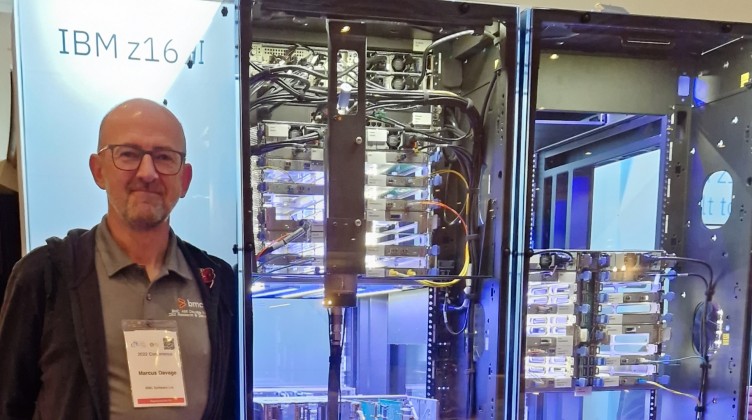Written By Marcus Davage, Open Mainframe Project Ambassador and Lead Product Developer at BMC Software

In 2022’s phenomenally successful GSE UK Region Conference, IBM wheeled out their latest mainframe, the IBM z16. I couldn’t resist having my photo taken next to the opened-up display model. But this display model isn’t the only thing that Open about the mainframe.
The Open Mainframe Project is a collaborative effort that seeks to promote the use of open source software on mainframe systems. The initiative was launched in 2015 by The Linux Foundation with the goal of bringing together industry experts to develop a shared vision for the future of mainframe computing.
Today, the Open Mainframe boasts more than 50 corporate members, including some of the biggest names in the tech industry, such as IBM, Red Hat, SUSE, Broadcom Mainframe Software and BMC Software. Together, these members work to create and promote open source software that can run on mainframe systems.
One of the key benefits of the OMP is that it allows companies to take advantage of the benefits of open source software, such as cost savings and flexibility, while still harnessing the power, performance, availability, security, resilience and reliability of mainframe systems. This is especially important in industries where mainframe systems are critical to business operations.
So what does it do?
The Open Mainframe Project has several open source projects under its umbrella, each of which serves a specific purpose. Here are a few examples:
– Zowe: an open source framework that allows developers to access mainframe resources using modern tools and interfaces.
– COBOL Programming Course: an online course that teaches COBOL programming, a language commonly used in mainframe systems.
– Ambitus: an open source project that allows mainframe developers to run Linux applications on z/OS, a popular mainframe operating system.
– ADE: an open source project that provides an integrated development environment (IDE) for mainframe developers.
By promoting the use of open source software on mainframe systems, Open Mainframe is helping to drive innovation and collaboration in the mainframe community.
How does it benefit my business?
If your business uses mainframe systems, there are several benefits to getting involved with the Open Mainframe Project:
1. Cost savings: By leveraging open source software, you can save money on licensing fees and reduce the overall cost of maintaining your mainframe systems.
2. Flexibility: Open source software provides more flexibility to tailor your mainframe environment to your specific needs, which can lead to better performance and efficiency.
3. Innovation: The Open Mainframe Project is driving innovation in the mainframe community by promoting collaboration and the development of open source tools and frameworks.
4. Talent acquisition: By embracing open source software, you may be able to attract developers who are passionate about working with the latest technology and contributing to the open source community.
5. Future-proofing: By embracing open source software on your mainframe systems, you can ensure that your business is prepared for the future and can adapt to changing technology trends.
Conclusion
The Open Mainframe Project is an exciting initiative that seeks to promote the use of open source software on mainframe systems. By doing so, the project is making mainframe computing more accessible and affordable, while also promoting innovation in the field. With its impressive list of members and open source projects, Open Mainframe is poised to play a significant role in the future of mainframe computing.
If you are interested in mainframe computing and open source software, the Open Mainframe Project is an initiative worth exploring. Consider getting involved by exploring the projects under the Open Mainframe umbrella, contributing to the community, or joining as a member. By doing so, you can help shape the future of mainframe computing and open source software.
Learn more:
- Click on News & Resources: https://openmainframeproject.org/news/
- Join the Conversation on Slack: https://openmainframeproject.slack.com/signup#/domain-signup
- Follow on Social: Twitter, LinkedIn & YouTube
- Subscribe to the monthly newsletter: https://openmainframeproject.org/